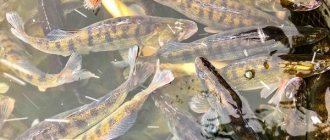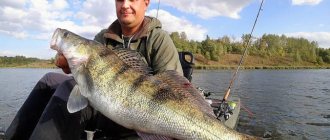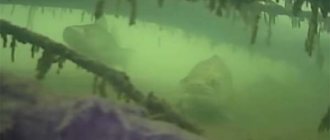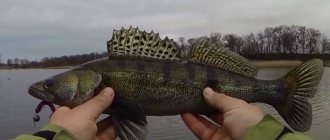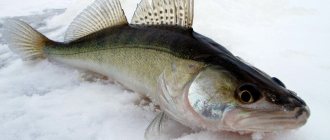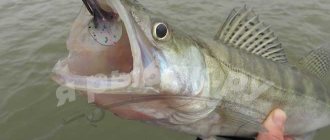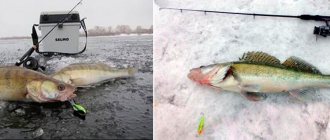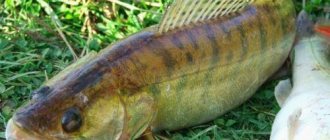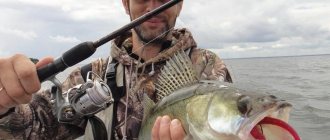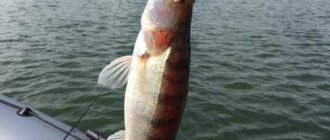Content
- Catching pike perch in winter with a spoon requires skill.
- Pike-perch on lures in winter - video for beginners
- The best lure for pike perch – what is it?
- History with geography What lures for pike perch America offered
- What do Scandinavians use to catch pike perch in winter?
- The best spinners “originally from the USSR” - do it yourself
- 1. Noisemaker tube
For those who are just discovering fishing for pike perch with lures in winter, it is quite difficult not to get confused in needles and pimples, tubes and trapezoids, Williams and admirals and decide for themselves which ones are better. In addition, it is not enough to buy and tie a spoon, you need to know how to fish with it in certain conditions, and this only comes with experience.
In this article, we set the task of giving a general description of the variety of winter lures for pike perch so that the words “castamaster”, “maropedka”, “pike perch”, “uchinskaya”, etc., form a coherent picture in the mind of a novice fisherman, and for an experienced fisherman - The zander fisherman had something to add in the comments to further clarify the specifics of fishing with this or that piece of oblong metal.
So.
Photo by user of the site FishingSib.ru Lech-154 “Bite”
The best silicone vibrating tails for pike perch
Vibrotail is a bait with a moving tip and a flexible body. It is the tip that plays in the water column, which lures the predator. For catching pike perch, long rigs with a fine structure and great mobility are suitable. It is better to use neutral flavors, avoiding sharp, aggressive odors that can alert the fish. Edible rubber is most preferable, especially when fishing in winter, when the predator has much less natural prey and hunger forces him to lose caution, rushing even to dubious objects.
Catching pike perch in winter with a spoon requires skill.
When catching pike perch in winter (with a spinner, a balancer or a vib, it doesn’t matter) the first difficulty is finding it. To do this, you need to know the fishing area, the places where pike perch prefer to stand, and be prepared to move a lot and drill a lot. Let's say a fish site has been discovered. In this case, experienced pike-perch fishermen leave the ice with their catch, but beginners still often end up without taking into account a number of nuances. In particular, sluggish pike perch prefers low-amplitude play and often bites during pauses. This determines the choice of both bait and wiring.
A typical retrieve when catching pike perch with a vertical spinner is a short throw - within 30 cm, and a long pause, which can reach 15 seconds. And monotonous, stable repetition of movements. But as for the specifics - speed, throw height, pause length - there can be no clear instructions, everything is selected intuitively and experimentally and comes only with experience.
Each pike perch bait has its pros and cons. Why do many fishermen prefer to catch pike perch in winter with a spoon rather than with a balance beam? Because, firstly, the main food of pike perch - small fish - when feeding, is located vertically, and the spoon, unlike the balancer, looks more natural in this light. Secondly, spinners can have a more varied game, and not just horizontal amplitude fluctuations.
Technique for catching pike perch using a spinner
When fishing with branded spoons, as mentioned earlier, it is better to use “Longs”. The Comets performed well. With their help it is easy to fish in calmer but deeper places.
Let's look separately at the technique of catching pike perch using a rotating Long spinner. Usually the bait is thrown into a deep-water area and waited until it reaches the bottom layer. After this, rewinding begins. You can use the simplest tactics when the lure is driven evenly at low speed. But with this method of fishing, there is a high probability of catching a pike if it is spinning near the bottom. If the depth in this place is more than 6-7 meters, then slow, uniform wiring is quite appropriate in this case. In this case, you can use loaded spoons and heavy models.
It is sometimes effective to change the speed of reeling in the bait during one retrieve. At first we drive it at a slow speed, and halfway through the journey we accelerate sharply. Sometimes it is useful to pull the spinning rod in different directions. Such uneven wiring gives the result when the pike perch is not very active and does not respond to uniform wiring.
When we are guiding through the main current, we use weighted “Longs”, which retain their performance even with strong water flows. Sometimes you have to load them with Cheburashkas or other weights.
At the beginning, we try to fish all the most promising areas on the river: rifts, drops, holes, spits, channel edges, etc. Don't stay in one place for too long. We tried different spinners and used different techniques for catching pike perch on a spinner. If there are no bites, we go or swim to another promising area.
It’s good if there is some kind of tree in the fishing area. In summer, pike perch likes to hide under such trees and hunt for fry near them. This is the first place from which we start trolling. It is advisable to avoid losing bait. You can also fish in a wade. If the pike perch is active, it behaves more boldly and is not so afraid of moving objects. In this case we use “Long” No. 3 weighing 10 grams. If there are no attacks within 5-10 minutes, then we move on.
If we go down the river, then we make drift casts, 30 meters perpendicular to the shore and pull the line. Next, it is better to give the current the opportunity to carry the bait. Reeling should be done already at the time when the bait is close to the shore.
When we go against the current, it is better to make casts at short distances, 20 meters at an angle. With this method, the angler stands behind the pike perch and the distance between them can be 7-8 meters. It is better to throw the bait in places located behind a small cape, where the direction of the current changes sharply. Many voles and confident walleye attacks occur when the bait hits the boundary between fast and slow currents. Such places are clearly visible and when the spinner passes this area, the tension of the fishing line decreases and a pleasant heaviness is immediately felt. The pike perch took it.
It must be said that fishing for pike perch in such areas does not always lead to successful hookups. Often weak and uncertain bites go unnoticed. And there are still snags, because we are driving the turntable in the bottom layer. To avoid snags, it is better to immediately remove the slack in the line after casting and, at the same time as reeling, lower the tip of the rod into the water. In this case, you can quickly feel the lure underwater.
The best lure for pike perch – what is it?
Form . Definitely narrow and oblong. This is exactly what the ideal lure for pike perch in winter should be. As is the pike perch food supply. Because the mouth of the fanged one is not particularly wide.
Weight . Opinions on this matter differ significantly. Range - from 5 to 30 g. Such a wide corridor has an explanation - the choice of the optimal weight in each specific situation is influenced by: the shape of the spoon and its “behavior” when falling, the fishing depth, the presence of a current, the season (first ice, deep winter or spring).
Length – from 5 to 10 cm. It is believed that baits exceeding these dimensions may interest winter pike perch to a lesser extent.
Color . It is widely believed that the best lure for pike perch in winter is silver.
Another important point in successfully catching pike perch is the sharpness of the hook, since the fanged mouth is strong, and bites in winter are often weak and delicate.
Photo by FishingSib.ru website user NikolaiM from the news “Be on trend!”
How to choose a spinner for pike perch?
One of the main qualities for lures for pike perch is their size and good flight qualities. These are quite large models, often weighted. These fly well and quickly fall to the bottom. It has been experimentally established that pike perch definitely catches better on long and heavy spinners. Small perches please him to a much lesser extent.
Another important point is bait casting. Throwing small and light spinners over long distances is problematic. These models can be used to fish from a boat when the distance to a hole or channel edge is short. But if pike perch takes them, it is small, up to 1 kg, and often up to 500 grams.
As for turntable numbers, the models with numbers 2-5 are most often used. Let us clarify that the spinner number does not always correspond to its size. It may turn out that the spinner of the fourth size is the same in size as the spinner of the second number. True, such a discrepancy is rare, so you shouldn’t worry too much about it. If you order baits online, then pay attention to the size and length of the petal and the weight of the bait. In a fishing store you can see whether the spinner in front of you is large or small.
What specific models can be recommended to a beginner or a spinning angler who has little experience in catching pike perch using spinners. First of all, we can recommend the Aglia Long spinner, numbers 2-3.
It can be considered universal. It is suitable for fishing in still and calm water. It shows almost the same game with different current strengths. This is due to the peculiarities of the petal shape. It is not only narrow, but also almost flat and made of thick sheet. With the help of such a bait it is easy to make movements near the very bottom, which is extremely important when fishing for pike perch along the edges and lower points of the drop-offs.
In general, spinners with minimal resistance to water flow are best suited for fishing for pike perch. The ideal shape of such baits would be conical with a slight angle at the top (less than 30 degrees). This lure goes well with and against the current. The performance of such a bait is not affected by the additional weight that comes in front of the petal.
In principle, you can make such a spinner yourself. You just need to find a sheet of metal of the required thickness and make such a conical surface. Another important element is the rod. It should be rigid, 8-10 cm long. The petal should not be closer than 1.5 cm to the tee tips. In this case, it will rotate correctly without clinging to the hooks. The general side view of such a spinner is as follows:
History with geography
In world fishing, three main branches of development of metal baits for winter pike perch can be distinguished, which have certain common features. This is an American, Scandinavian direction and what we can conditionally call “originally from the USSR.”
What lures did America offer for pike perch?
The Acme company can be considered the ancestor of American spinners working for winter pike perch. It was she who put into production the famous Kastmaster , developed in the 50s of the last century by Art LaValle and which became a household name denoting a specific type of spinner - a cylindrical blank, cut at the top and bottom at certain angles (17° and 23°).
Another authentic American product is the “ Swedish Pimple” from Bay De Noc, which has been produced for over 50 years. The spinner is cast, has a smooth or pimpled surface, is available in various colors, and is shaped like an oblong petal. It is considered to be excellent for fishing on the first ice and in the dead of winter.
We owe the appearance of the Williams Ice Jig spinner to Canadian designers , a feature of which is the presence of two soldered hooks, supposedly reducing the number of derailments. We will hardly find particularly enthusiastic reviews of this bait from domestic fishermen, but many emphasize its versatility.
In the photo from left to right are spinners from the American continent: castamaster, Swedish pimple, Williams ice jig
What do Scandinavians use to catch pike perch in winter?
There is an opinion that Scandinavian winter lures for pike perch are not particularly suitable for catching large fish. However, these lures are well designed and designed for a wide range of fishing conditions. A specific feature of most Scandinavian spinners is that they are equipped with hooks on a hanging chain. Accordingly, when retrieving, pauses of 10 seconds or more are desirable to avoid the hook getting caught in the fishing line. The Scandinavians, namely the Finnish company Puustjärven, gave the world fishing such famous pike-perch spoons as Alaska, Hopeasiipi and Veteran.
Alaska is considered a classic. A long, voluminous metal plate is flat on one side and has a convex hump on the other. When planning freely, maintaining the horizontal, it seems to flutter from side to side.
Hopeasipi (translated as “silver wing”) has the shape of an elongated triangle and intense play with sweeping oscillations and wagging of the tail. The unusual pronunciation of the word “hopeasipi” has led to the fact that this lure is popularly called hipisipi, hopea and even hipipisya. You need to get used to handling this bait in every sense.
Veteran is another type of pike perch lure. Unlike the Scandinavians mentioned above, it has wings that allow the polished piece of metal to make not so much oscillations under water as wide gliding movements and diving.
Note that this is not the entire list of catchable pike-perch Scandinavian baits, but, perhaps, their main types.
In the photo, from left to right, Scandinavian spoons: Alaska, Hopeasipi, Veteran
The best spinners “originally from the USSR” - do it yourself
They were called mainly either by the name of their inventors, or by their form. The most famous include Vlasovskaya, Uchinskaya, Matveychikov’s spinner, Maropedka, V.A. Cobra. Yudenko, Sabanuev triangular (coffin, trapezoid). We also have a fairly wide range of homemade spinners, the roots of the invention of which we have not been able to reliably restore. Among them: hexagon (impeller), tube, beam, boat, needle, nurse, curved knife, clove, pike perch, etc. There are really a lot of varieties.
Perhaps the only domestic spinner produced in the USSR industrially and working on pike perch in winter is the famous heavy Atom, born in the 50s. last century. Although it can be considered more as a bait for pike. By the way, the workers dubbed it “Atom”, seeing an external resemblance to an atomic bomb.
In order to immediately prevent any disputes arising regarding the correspondence of the picture to the title, let’s say that often different authors and sources (including authoritative ones) attach completely different images to the same names. For example, under the guise of the “famous Vyatka spinner” we will also find S.M. Muravlev model 1917, and what we know as the “pipe”.
Photo by FishingSib.ru website user NikolaiM from the news “Launch of the Kite”
The Vlasov spinner (I.M. Vlasov’s spinner) turned 70 years old this year - its drawings were first published in 1949 in the anthology “Fisherman-Sportsman”. Now the idea of the original form is, if not lost, then significantly blurred. The only obvious thing is that it should be oblong, “have a noticeable transverse steepness and a slight longitudinal bend.” The game should be smooth, then it moves diagonally, oscillating finely. Just what passive fish need.
The shape of the Uchin spinner was described back in the 50-60s. last century, received its name from the Uchinsky reservoir. Characterized by active play, good for finding fish. Made from a combination of cupronickel and brass. It is often recommended for novice fishermen and when fishing at depths of 4 to 8 m.
Vladimir Matveychikov's spinner is well known in the world of sport fishing. It works best at a depth of 1.5 to 5 m. Despite the simplicity of the form (you can easily make it yourself), it is characterized by stable play - moving to the side with swaying sides.
In the photo from left to right: Vlasov spinner, Uchinskaya spinner, Matveychikov spinner
Maropedka was born as an attempt to make a copy of Matveychikov’s spinner, but the inventor (A. Vorobyov) was unable to repeat the exact author’s bend, so the result was a mix of Matveychikov’s spinner, Rhombus and torpedo – Maropedka, which showed itself as a catchable bait, for which they work as short and sharp strokes, and smooth discharges.
Kobra V.A. Yudenko , in the opinion of its author, combines oscillations without rotation, buoyancy at a certain rate of movement and vibration of the tail section. All this increases catchability and protects the fishing line (cord) from twisting.
Needle , another winter lure for pike perch among the catchy home-made products, opens up in skillful hands. There are overlaps, but if you choose the wiring, it works smoothly. Pike perch, perch and pike bite on it. True, it is not suitable for shallow depths up to 2 m.
In the picture from left to right: Maropedic, Cobra, Needle
The tube (flute) is a steel or brass tube with the ends cut at an angle: at the tee - 60°, at the top - 30° (or according to other sources, 30° and 45°, respectively). Today they are hollow, sealed and composite. Well suited for beginner fishermen.
The author of the trihedron (coffin, trapezoid) is considered to be the famous former Leningrad spinning player Viktor Sabunaev. In addition to Sabunaev’s version, there were others, but it was this master who introduced the “gold standard” of the bait.
The hexagon (impeller) is one of the most “ancient”, simple and widespread types of spinners until recently. It is distinguished by its relatively large weight and monotonous play. When falling, it moves slightly, but due to its large weight it creates long-damping vibrations, which can provoke a passive predator.
In the picture from left to right: tube, trihedron, twisted hexagon
Types of spinners for catching pike perch vertically
This is not the entire list of pike perch spinners. There are such well-known homemade products as a needle, a ray, a nail, a boat, a nurse, a pike perch... There are so many of them, how to figure them out? For this, in fact, it is important to know that all pike-perch spoons are divided into three types.
A jig is a heavy, narrow-bodied spoon bait designed for fishing at great depths. Initially developed for sea fishing. The classic proportions of length and width are 6:1. It is believed that jigs do not have any pronounced independent play as such. Therefore, they are quite easy to learn and are well suited for beginner fishermen. Also, due to moderate oscillatory movements, they are used on passive fish. We will conditionally classify as jigs: Kastamaster, Alaska, Vlasovskaya, Uchinskaya spoons, tube, hexagon, needle, nail, nurse, boat. As you can see, this category is numerous.
The loose material floats slowly, as if crumbling to the bottom. The center of gravity, as a rule, is located almost in the center, due to which the spoon does not fall, but trembles, slowly descending. Such lures include the Swedish pimple, Hopeasipi, trihedron, beam, Matveychikov's spoon, Maropedka and pike perch.
The gliding spoon actively deviates from the vertical, due to which it is able to fish a fairly wide area of water and attract a larger number of predators. Classic gliding lures are Williams Ice Jig, Veteran, Cobra and Atom.
In the photo from left to right: a typical jig, a loose jig (beam) and a planning spoon
How will this classification help us? Very simple. Now we have a general idea of what bait geometry leads to what underwater behavior - docile or expressive-dynamic. And when choosing a spinner, we know that:
- firstly, the more complex the movement of the bait underwater, the more difficult it is to animate it effectively;
- secondly, the more passive the fish, the calmer the behavior of the spoon should be;
- thirdly, the more actively the bait moves, the larger the water area under the ice you can fish, which is good when searching for fish.
Photo by FishingSib.ru website user NikolaiM from the news “The heat has gone!”
The next question is - from what is described above, what kind of spoon can you buy and catch? That is, what is the actual TOP of the best lures for pike perch?
The best silicone imitations for pike perch
The task of an imitation bait is simple and straightforward. She needs to deceive the fish, convincing it that it is a real frog or larva. In theory, everything is simple, but pike perch is too cautious and reacts not only to appearance, but also to behavior, as well as smell. In addition, the structure of the mouth of a fanged predator should be taken into account. It is narrow and does not open as wide as that of a pike. He simply cannot swallow some equipment, which means he will not even try. Separately, you will have to stock up on attractants, that is, flavorings. Imitations are rarely edible or flavorful. Even without this, they are more expensive than vibrotails or twisters.
TOP 10 - the best lures for pike perch
Compiling any rating, and especially rating lures, is a rather thankless task; the choice of a particular angler is very subjective. The numbers under which baits are listed do not at all indicate their level of popularity. This is simply a numbering adopted for ease of presentation.
Our rating included spinners such as jigs and loose lures, produced industrially ( not homemade ) and falling into the conditionally budget range - up to 500 rubles (with the exception of the odious “pimple”). Perhaps we have overlooked something. Be sure to write about it in the comments.
Noisemaker tube
You can buy it, or if you have some skill, you can make it yourself. Simple, proven, famous. It is with a noisemaker tube that beginners often begin to master the winter pike-perch spinner. Classic jig.
ECOPRO Shprot
This spinner, relatively new in the model range of the St. Petersburg company ECOPRO, is rapidly gaining popularity. Fishing store sellers say that more and more people are coming to them specifically for sprat.
Halco Twisty
“Halka” has long been considered a classic of winter pike perch fishing. The original from Twisty is reliable, proven, and 100% catchable. By the way, the spinner is Australian. It belongs to the dry type and has a very interesting game.
ECOPRO Alaskan
This spoon is a duplicate of the famous Scandinavian Alaska. Like many replicas from ECOPRO, it showed its good side. Our Alaska is accessible - both in price and in availability in stores, unlike true Puustajarven. And at the same time he catches himself quite well.
Admiral zander
This spoon is more popular in the European part of our country, it is considered a jig, comes in all sorts of colors and is available in a wide range of weights. The Admiral behaves steadily in the current and at the same time is very affordable.
Sudakovaya
Another budget jig with nickel silver, coated with phosphor, which is great for attracting pike perch under the ice. The pike-perch spinner from the series is cheap and cheerful, easy to use, suitable for beginner anglers, a must-have, in general.
ECOPRO Sudachya
This St. Petersburg powder on our reservoirs can rightfully be considered a classic. Many anglers have zander from ECOPRO in their arsenal and successfully fish with it.
Bay De Noc Swedish Pimple
The same “Swedish pimple”. Yes, it’s not cheap - the original costs more than 500 rubles, USA, whatever you wanted. But absolutely catchy. Although I can’t say that it’s particularly easy to use.
KOI Striped Iceberg
An imported derivative of the trihedron-bulk originating from Japan. The shape allows it to be used not only as a vertical spinner, but also for horizontal fishing. By the way, KOI Striped Iceberg is forged.
Nord Waters Nirvana
In our country, craftsmen make analogues of Nirvana of the Northern Waters from old tweezers. The ribs on it are designed for hydroacoustic effect. Not to say that it is particularly popular in wide circles, but it catches pike perch perfectly. The price is average.
Many of the domestically invented spinners mentioned in this article can be made with your own hands if you wish, or you can turn to those who already do it well.
We hope you found the material useful or at least informative. We are waiting for your additions to our vision in the comments to the article!
The best silicone twisters for pike perch
The main feature of the twister is its large complex tail. It can bend and twist repeatedly. Everything to ensure that the tackle behaves most naturally in the water. A twister for catching pike perch is used most often, as it is mobile and can make sudden movements, both horizontally and vertically. It is much more difficult to choose the right twister. Manufacturers are constantly experimenting with shape, and some equipment behaves in the most unnatural way. While you can still catch a perch using such a decoy, it definitely won’t work with pike perch.

